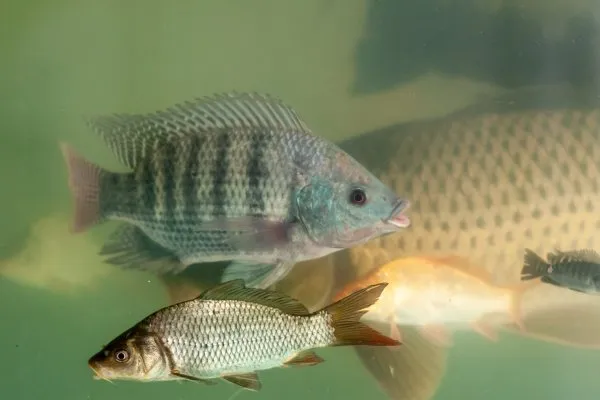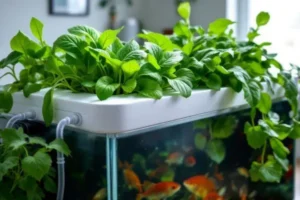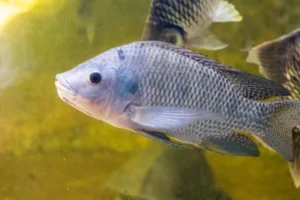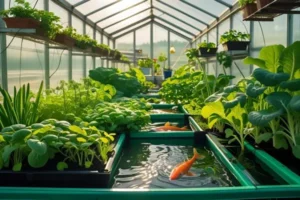When it comes to building a successful aquaponics system, choosing the best fish for aquaponics is arguably one of the most critical decisions you’ll make. The fish you select will directly impact your system’s productivity, maintenance requirements, and overall success. Whether you’re a beginner planning your first backyard setup or an experienced grower looking to optimize a commercial operation, understanding which fish species thrive in aquaponics environments is essential.
Did you know that the right fish choice can increase your system’s efficiency by up to 40% while reducing maintenance time by half? The fish in your aquaponics system aren’t just providing nutrients for your plants – they’re the living engine that drives your entire ecosystem. From hardy tilapia that can tolerate fluctuating water conditions to elegant trout that produce premium-quality protein, each species brings unique advantages and requirements to your setup.
The symbiotic relationship in aquaponics relies heavily on fish waste conversion through the nitrogen cycle. Fish produce ammonia through their waste and respiration, which beneficial bacteria convert into nitrites and then nitrates – the perfect plant food. However, not all fish species are created equal when it comes to aquaponics fish selection. Some produce more waste, others are more sensitive to water parameter fluctuations, and certain species grow faster or require specific temperature ranges.
Successful aquaponics fish farming depends on matching your chosen species to your specific system requirements, climate conditions, and production goals. A thriving tilapia might be perfect for a warm greenhouse setup, while trout could be ideal for outdoor systems in cooler climates. Similarly, ornamental species like goldfish or koi can create beautiful aquaponics displays while still providing adequate nutrients for plant growth.
Common challenges faced by aquaponics enthusiasts include fish mortality due to poor species selection, stunted plant growth from inadequate nutrient production, and system crashes from incompatible fish-to-plant ratios. These issues often stem from choosing fish based on availability rather than suitability for aquaponics environments.
In this comprehensive guide, we’ll explore the top 10 best fish for aquaponics systems, breaking down their specific care requirements, ideal growing conditions, and compatibility with different system sizes. You’ll discover how to match fish species to your climate, space constraints, and production goals, while avoiding the common mistakes that can derail even the most promising aquaponics venture.
By the end of this article, you’ll have the knowledge and confidence to select the perfect fish species for your aquaponics system, ensuring both thriving plants and healthy, productive fish that will provide years of sustainable food production and potentially significant cost savings on your grocery bills.
What Makes a Fish Ideal for Aquaponics Systems?
Selecting the best fish for aquaponics requires understanding four fundamental characteristics that determine whether a species will thrive in your system. These criteria separate successful aquaponics fish species from those that struggle or fail in recirculating environments. Let’s examine each essential factor that makes certain fish perfect for aquaponics fish farming.
Water Quality Tolerance
The most crucial trait for aquaponics fish selection is tolerance to varying water conditions. Unlike natural environments where fish can migrate to better conditions, aquaponics fish must adapt to the specific parameters of your system. Ideal fish species can handle fluctuations in pH levels (typically 6.8-7.2), dissolved oxygen variations, and occasional spikes in ammonia or nitrites during system cycling.
Hardy species like tilapia demonstrate exceptional water quality tolerance, surviving in conditions that would stress more sensitive fish. They can withstand pH swings, temporary oxygen depletion, and even brief exposure to elevated ammonia levels – making them perfect for beginners learning system management. Conversely, delicate species require stable, pristine conditions that may be challenging to maintain consistently.
Growth Rate and Feed Conversion
Efficient fish for hydroponic systems exhibit rapid growth rates and excellent feed conversion ratios (FCR). The FCR measures how effectively fish convert feed into body weight – lower numbers indicate better efficiency. Top aquaponics fish typically achieve FCRs between 1.2:1 to 2.0:1, meaning they gain 1 pound of weight for every 1.2-2.0 pounds of feed consumed.
Fast-growing fish provide several advantages: quicker harvest cycles, more consistent waste production for plant nutrition, and better economic returns for commercial operations. Species like catfish and tilapia can reach market size in 6-8 months under optimal conditions, while slower-growing fish may require 12-18 months.
Temperature Requirements
Warm water aquaponics fish and cold water aquaponics fish have distinct temperature preferences that must align with your local climate and system capabilities. Tropical species like tilapia and barramundi thrive in temperatures between 75-85°F (24-29°C), while cold-water species like trout prefer 55-70°F (13-21°C).
Temperature directly affects fish metabolism, growth rates, and oxygen requirements. Maintaining inappropriate temperatures leads to stressed fish, reduced growth, increased disease susceptibility, and poor waste production for plant nutrition.
Disease Resistance
Sustainable fish production depends on naturally resilient species that resist common aquaculture diseases. Hardy fish reduce the need for medications, which can disrupt beneficial bacteria essential for the nitrogen cycle. Disease-resistant species maintain consistent waste production and minimize system disruptions, ensuring stable plant nutrition and reducing management stress for growers.
Top 10 Best Fish Species for Aquaponics
Choosing from the best fish for aquaponics can seem overwhelming, but these ten species have proven themselves as reliable performers across diverse system types and climates. Each offers unique advantages for different aquaponics applications, from beginner home systems to commercial operations.
1. Tilapia – The Aquaponics Champion
Tilapia aquaponics remains the gold standard for good reason. These African natives tolerate pH ranges from 6.5-8.5, survive in temperatures between 70-85°F (21-29°C), and achieve excellent feed conversion ratios of 1.3:1. Tilapia reach market size (1-2 pounds) in 6-8 months and produce consistent waste for optimal plant nutrition.
2. Trout – Perfect for Cool Climate Systems
Trout aquaponics excels in cooler environments, thriving in 55-70°F (13-21°C) water. Rainbow trout offer premium-quality protein and grow rapidly in proper conditions. They require high dissolved oxygen levels (6+ ppm) and excellent water quality, making them ideal for experienced growers in northern climates.
3. Catfish – Hardy and Fast-Growing
Catfish aquaponics provides exceptional resilience and adaptability. Channel catfish tolerate poor water quality, wide temperature ranges (65-85°F/18-29°C), and achieve excellent growth rates. Their bottom-feeding behavior helps clean excess feed, reducing system maintenance requirements.
4. Largemouth Bass – Premium Choice for Advanced Systems
Largemouth bass represent the premium end of aquaponics fish species, commanding high market prices. They require experienced management, stable water conditions, and often benefit from companion fish for optimal growth. Bass thrive in 70-80°F (21-27°C) water with abundant dissolved oxygen.
5. Bluegill – Excellent for Beginners
Best aquaponics fish beginners often start with bluegill due to their forgiving nature and adaptability. These panfish tolerate temperature ranges from 65-80°F (18-27°C), accept various feeds, and reproduce readily in aquaponics environments.
6. Carp – Extremely Resilient Option
Common carp demonstrate unmatched hardiness, surviving in challenging conditions that would stress other species. They tolerate wide temperature ranges, poor water quality, and provide consistent waste production for fish tank aquaponics applications.
7. Perch – Great for Small-Scale Systems
Yellow perch work excellently in compact aquaponics system fish setups. They prefer cooler water (60-75°F/16-24°C), grow steadily, and provide delicious white meat for the dinner table.
8. Goldfish – Ideal for Ornamental Aquaponics
Goldfish offer beauty and function in decorative systems. While not grown for food, they provide adequate nutrients for plants and create visually appealing displays.
9. Koi – Beautiful and Functional
Koi combine ornamental value with excellent waste production. These decorative carp tolerate various conditions and can live for decades with proper care.
10. Barramundi – Tropical Powerhouse
Barramundi excel in warm climates, growing rapidly and providing premium white fish. They require consistent warm temperatures (78-86°F/26-30°C) and excellent water quality.
Fish Selection Based on System Size and Climate
Matching aquaponics fish species to your specific system size and local climate is crucial for long-term success. The wrong choice can lead to stunted growth, system imbalances, and disappointing harvests. Understanding these key factors ensures optimal performance from your fish for hydroponic systems.
Best Fish for Small Home Aquaponics Systems
Best aquaponics fish beginners should focus on hardy, compact species suited for limited space. Small home systems (50-200 gallons) perform best with bluegill, goldfish, or young tilapia. These fish tank aquaponics species require minimal space while providing adequate nutrient production for 10-20 plant sites.
Bluegill excel in 55-gallon systems, reaching 6-8 inches and producing sufficient waste for leafy greens and herbs. Their slow growth prevents overcrowding, while their tolerance for varying conditions makes them forgiving for new aquaponics enthusiasts. Goldfish offer similar benefits with added visual appeal, though they’re not suitable for consumption.
For slightly larger home systems (200-500 gallons), juvenile tilapia work excellently. Start with 10-15 fingerlings in a 200-gallon tank, allowing room for growth while maintaining proper aquaponics fish stocking densities. These systems can support 30-50 plant sites with vegetables like lettuce, spinach, and tomatoes.
Commercial-Scale Fish Recommendations
Aquaponics fish farming at commercial scales (1,000+ gallons) opens opportunities for faster-growing, higher-value species. Tilapia aquaponics dominates commercial operations due to rapid growth, excellent feed conversion, and market acceptance. Stocking densities can reach 1 pound of fish per 2-3 gallons in well-managed systems.
Catfish aquaponics provides another excellent commercial option, particularly in southern regions. Channel catfish achieve market weight (1.5-2 pounds) in 8-10 months with proper management. Their hardy nature reduces mortality risks, crucial for commercial viability.
Trout aquaponics commands premium prices but requires sophisticated temperature control and high-quality feeds. Commercial trout operations often achieve 8−12perpoundcomparedto3-5 for tilapia.
Cold Climate vs. Warm Climate Considerations
Cold water aquaponics fish like trout, perch, and northern pike thrive in naturally cool environments or unheated greenhouse systems. These species maintain active metabolism in 45-65°F (7-18°C) water, reducing heating costs significantly.
Warm water aquaponics fish including tilapia, catfish, and barramundi require consistent temperatures above 70°F (21°C). While heating costs increase operational expenses, these species typically exhibit faster growth and better feed conversion rates.
Climate-appropriate species selection can reduce operational costs by 30-50% while improving overall system stability. Northern operators often choose cold-water species or invest in geothermal heating, while southern growers leverage natural warmth for tropical species production.
Essential Care Requirements for Aquaponics Fish
Proper aquaponics fish care extends far beyond species selection. Understanding fundamental care requirements ensures healthy fish, consistent plant nutrition, and system longevity. These essential practices apply regardless of which best fish for aquaponics you choose for your setup.
Feeding Guidelines and Nutrition
Fish feeding aquaponics directly impacts both fish health and plant nutrition quality. Feed high-quality commercial pellets containing 28-35% protein for optimal growth and waste production. Overfeeding represents the most common mistake, leading to poor water quality and system crashes.
Follow the “5-minute rule” – provide only what fish can consume completely within 5 minutes, typically 1-3% of fish body weight daily. Split daily portions into 2-3 smaller feedings to improve digestion and nutrient absorption. Monitor uneaten feed carefully, as excess food decomposes, creating toxic ammonia spikes.
Premium fish feeds cost $0.80-1.50 per pound but deliver superior feed conversion ratios and consistent waste composition. Avoid cheap feeds containing excessive fillers, which produce poor-quality waste and stunted fish growth. Supplement occasionally with live foods like earthworms or black soldier fly larvae for enhanced nutrition.
Water Parameter Management
Water quality fish requirements demand consistent monitoring and adjustment. Test pH weekly, maintaining levels between 6.8-7.2 for optimal fish health and bacterial activity. Monitor ammonia and nitrite levels during system cycling and after feeding increases, ensuring levels remain below 0.5 ppm.
Dissolved oxygen should stay above 5 ppm through adequate aeration and water circulation. Temperature stability prevents fish stress – maintain species-appropriate ranges with gradual changes only. Install backup aeration systems to prevent catastrophic fish losses during power outages.
Test kits cost $30-60 but provide essential data for aquaponics fish management. Digital meters offer convenience but require regular calibration. Log water parameters weekly to identify trends and prevent problems before they become critical.
Disease Prevention and Treatment
Fish health aquaponics relies primarily on prevention rather than treatment. Quarantine new fish for 2-3 weeks before introducing them to established systems. Maintain optimal water quality, avoid overcrowding, and provide proper nutrition to boost natural immunity.
Common symptoms include lethargy, loss of appetite, unusual swimming patterns, or visible spots and lesions. Salt baths (1-3%) can treat minor infections without disrupting beneficial bacteria. Severe outbreaks may require antibiotics, but these can crash the nitrogen cycle.
Stocking Density Recommendations
Aquaponics fish density balances fish welfare with nutrient production needs. Conservative stocking (1 pound fish per 5-10 gallons) works best for beginners, while experienced growers can manage 1 pound per 2-3 gallons with excellent filtration and monitoring.
Higher densities increase waste production but require more frequent water testing, enhanced aeration, and careful feed management to prevent system overload.
Common Mistakes When Choosing Aquaponics Fish
Even experienced growers can make costly errors when selecting aquaponics fish species. Understanding these common pitfalls helps prevent system failures, fish mortality, and disappointing harvests. Learning from others’ mistakes saves time, money, and frustration while building sustainable fish for hydroponic systems.
Overstocking Problems
Aquaponics fish stocking mistakes rank among the most destructive errors beginners make. The temptation to maximize fish numbers seems logical – more fish should equal more nutrients for plants. However, overstocking creates a cascade of problems that can crash entire systems within weeks.
Excessive fish densities rapidly deplete dissolved oxygen, especially during warm weather or power outages. Fish begin gasping at the surface, stop feeding, and become susceptible to diseases. Waste production overwhelms biological filtration capacity, causing dangerous ammonia and nitrite spikes that poison both fish and beneficial bacteria.
A classic example: stocking 50 tilapia fingerlings in a 100-gallon tank seems reasonable initially. However, as fish grow to market size (1-2 pounds each), the system becomes severely overcrowded. What started as appropriate fish tank aquaponics density becomes a toxic environment requiring constant intervention.
Conservative stocking allows fish to reach full potential while maintaining system stability. Start with fewer fish and add gradually as your experience and system capacity expand. Remember, healthy fish in properly stocked systems outperform stressed fish in overcrowded environments.
Temperature Mismatches
Choosing cold water aquaponics fish for warm climates or warm water aquaponics fish for cool regions leads to perpetual struggles. Fish living outside their optimal temperature ranges exhibit stunted growth, poor feed conversion, and increased disease susceptibility.
Trout enthusiasts in Arizona often attempt trout aquaponics without considering cooling costs and complexity. Maintaining 60°F (16°C) water in 110°F (43°C) ambient temperatures requires expensive chilling systems and dramatically increases operational costs. Similarly, growing tilapia in unheated Minnesota greenhouses during winter results in torpid fish that barely eat or grow.
Climate-appropriate species selection eliminates these struggles entirely. Northern growers achieve excellent results with trout, perch, and northern pike, while southern operators excel with tilapia, catfish, and barramundi.
Incompatible Species Combinations
Mixing predatory and prey species creates constant stress and unpredictable losses. Largemouth bass paired with small bluegill often results in expensive bass meals rather than system harmony. Different species also have varying water quality requirements that may conflict.
Size disparities cause problems even among compatible species. Large fish intimidate smaller ones during feeding, leading to uneven growth and potential starvation. Aggressive species like some cichlids can stress peaceful fish regardless of size compatibility.
Successful aquaponics fish farming typically focuses on single species or carefully matched combinations with similar requirements and temperaments.
Conclusion
Selecting the best fish for aquaponics forms the foundation of every successful system, whether you’re building a small backyard setup or planning a commercial operation. Throughout this comprehensive guide, we’ve explored how the right fish choice can dramatically impact your system’s productivity, maintenance requirements, and long-term sustainability.
The key principles we’ve covered – water quality tolerance, growth rates, temperature requirements, and disease resistance – serve as your roadmap for making informed decisions. Tilapia aquaponics continues dominating the field due to exceptional hardiness and rapid growth, while trout aquaponics offers premium value for cool-climate growers. Catfish aquaponics provides middle-ground reliability for diverse conditions, and ornamental species like goldfish create beautiful, functional displays.
Remember that successful aquaponics fish farming extends beyond species selection. Proper stocking densities, appropriate feeding regimens, consistent water parameter management, and climate-appropriate choices determine whether your system thrives or struggles. The common mistakes we’ve highlighted – overstocking, temperature mismatches, and incompatible species combinations – can devastate even well-planned systems.
Your aquaponics fish selection should align with three critical factors: your experience level, local climate conditions, and production goals. Beginners benefit from hardy species like bluegill or goldfish in smaller systems, while experienced growers can manage premium species like bass or barramundi in commercial operations. Climate-appropriate choices reduce operational costs by 30-50% while improving system stability and fish health.
The fish for hydroponic systems you choose today will influence your aquaponics journey for months or years ahead. Take time to honestly assess your capabilities, research local regulations, and plan for system expansion. Consider starting with proven species like tilapia or catfish before advancing to more challenging options.
Looking ahead, aquaponics technology continues evolving with automated monitoring systems, improved feeds, and selective breeding programs developing hardier fish strains. IoT sensors now provide real-time water quality data, while mobile apps help track feeding schedules and growth rates. These innovations make successful aquaponics fish care more accessible than ever before.
The future of sustainable food production increasingly relies on systems like aquaponics that maximize efficiency while minimizing environmental impact. Your fish selection decision contributes to this larger movement toward responsible agriculture and food security.
Start your aquaponics success story today! Which fish species best matches your climate and experience level? Share your aquaponics plans and questions in the comments below – let’s build a community of successful growers helping each other thrive. Your experience could inspire someone else to begin their sustainable food production journey!
Frequently Asked Questions (FAQ)
What is the absolute best fish for aquaponics beginners?
Tilapia aquaponics offers the best combination of hardiness, growth rate, and forgiveness for beginners. Tilapia tolerate pH fluctuations (6.5-8.5), wide temperature ranges (70-85°F/21-29°C), and poor water quality better than most species. They grow quickly, convert feed efficiently, and provide consistent waste production for plant nutrition. Bluegill serves as an excellent alternative for cooler climates or ornamental systems.
How many fish can I stock in a 100-gallon aquaponics system?
For aquaponics fish stocking in a 100-gallon system, start conservatively with 10-15 tilapia fingerlings or 20-25 smaller species like bluegill. As fish grow, maintain no more than 20-30 pounds of mature fish total weight. This provides adequate nutrients for 30-50 plant sites while maintaining healthy water quality. Always prioritize fish welfare over maximum stocking density.
Can I mix different fish species in the same aquaponics system?
Mixing aquaponics fish species requires careful consideration of compatibility, size, and water requirements. Avoid combining predators (bass, pike) with smaller prey fish (bluegill, goldfish). Successful combinations include different sizes of the same species or compatible species with similar water needs, like tilapia with catfish. However, single-species systems generally perform more predictably and require less management.
What’s the difference between cold water and warm water aquaponics fish?
Cold water aquaponics fish (trout, perch, northern pike) thrive in 45-65°F (7-18°C) water and remain active in cooler temperatures. Warm water aquaponics fish (tilapia, catfish, bass) require 70-85°F (21-29°C) for optimal growth and become lethargic below 65°F (18°C). Choose species appropriate to your climate to minimize heating/cooling costs and maximize fish health.
How often should I feed my aquaponics fish?
Fish feeding aquaponics schedules depend on species, size, and water temperature. Feed adult fish 2-3 times daily, providing only what they consume within 5 minutes. Young, rapidly growing fish may require 4-5 smaller feedings. Reduce feeding frequency in cooler weather when fish metabolism slows. Overfeeding causes more problems than underfeeding in aquaponics systems.
When can I harvest my aquaponics fish?
Harvest timing varies by species and market preferences. Tilapia reach 1-2 pounds in 6-8 months, catfish achieve market size in 8-10 months, and trout can be harvested at 8-12 inches after 10-14 months. Fish tank aquaponics allows selective harvesting – remove larger fish while allowing smaller ones to continue growing, maintaining system balance.
Do I need special permits for aquaponics fish?
Aquaponics fish farming regulations vary by location and scale. Home hobbyists typically need no permits, but commercial operations may require aquaculture licenses, water use permits, and food safety certifications. Check with local agricultural extension offices and regulatory agencies before starting commercial operations or introducing non-native species.
What fish work best for indoor aquaponics systems?
Indoor best fish for aquaponics include species tolerating controlled environments and artificial lighting. Tilapia, goldfish, and small catfish species perform excellently indoors. Consider ornamental species like koi or goldfish for living spaces where appearance matters. Ensure adequate aeration and temperature control for chosen species.



